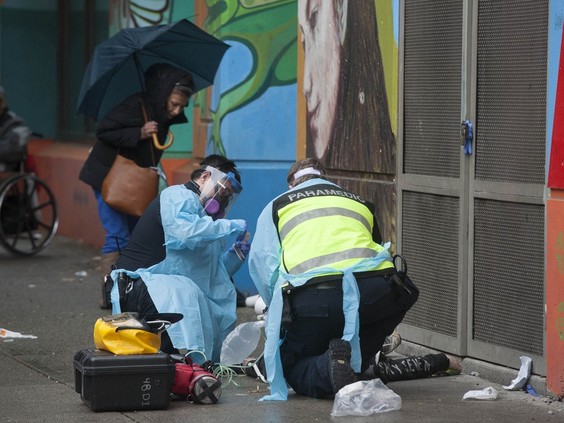British Columbia's Experimental 'Safer Supply' Flop
"A significant portion of the opioids being freely prescribed by doctors and pharmacists are not being consumed by their intended recipients.""[Those opioids are being trafficked]provincially, nationally and internationally.""As long as [safer supply] gives valuable things away for free, or for far below market prices, one should expect there to also be 'profiteers' wishing to profit by obtaining supply for resale."Leaked B.C. document"You can stand in front of just about any of these pharmacies that are involved in this -- usually close to the safer supply prescribing office -- and you can sit outside for five minutes and watch all kinds of transactions going down."Addiction outreach worker David McEvoy"We have noted an alarming trend over the last year in the amount of prescription drugs located during drug trafficking investigations, noting they are being used as a form of currency to purchase more potent, illicit street drugs."RCMP spokesperson Cpl. Jennifer Cooper"We have been concerned about this increasingly polarized rhetoric that is not informed by evidence, that is not paying attention to evidence, as a matter of fact, and is sharing opinion or anecdote that, in fact, is clearly not defensible if you look at the data.""[Hydromorphone was not] present in a significant number [of the bloodstreams of the roughly 200 people per month dying of overdoses in B.C.]"Former B.C. Chief Coroner Lisa Lapointe
 |
| Some pharmacies are paying cash kickbacks to vulnerable patients in Vancouver’s Downtown Eastside to attract more business — years after crackdowns related to the practice. Still from video |
For
years health officials in British Columbia dismissed concerns expressed
relating to freely handed out opioids to drug addicts through 'safer
supply' outlets, in a program designed to charitably provide a product
considered safer than street opioids, in an effort to wean people off
more dangerous drugs like fentanyl in response to an epidemic of deadly
overdoses. Those overdoses have occurred across Canada, but British
Columbia remains the poster child of drug-induced accidental overdoses.
Which
is what led the government of B.C. to develop a ground-breaking system
of 'safer supply', representing, since 2020, one of the world's most
comprehensive such programs. Once the program was operational, sharp
eyes began to notice a proliferation in the illicit street market of
diverted opioids and it wasn't difficult to conclude that the giveaway
drugs were being sold on the black market in exchange for more powerful
drugs like fentanyl.
And
while the less dangerous drugs were selling on the street at very
competitive prices, they lured teenagers into venturing into the
temptation of 'trying them out', creating a new generation of drug
users.
The
evidence of diversion was clear, and investigative reportage delved
into the problem, publishing their damning results; the larger
availability of drugs flooding the marketplace thanks to 'safer supply'
initiatives, doing far more harm to society broadly; in effect enabling
addicts who spurned the lesser highs of hydromorphone for the attraction
of infinitely more potent (and dangerous) fentanyl-laced street
drugs. These were dismissed by the province's health authorities as
unsubstantiated rumours and 'false news'.
This
week, however, the provincial Opposition Conservatives in the province
released a leaked presentation that had explored the issue without
prejudice, finding that those accusations of 'safe supply' boosted
opioid availability at the street level, and leading in fact to more
accidental drug overdoses rather than preventing them as intended, were
indeed reflecting reality. The Conservatives labelled the issue of
diversion, as evidence of "taxpayer-funded drug trafficking".
 |
The
undeniable evidence that the government health authorities had been
apprised, despite their denials, even led B.C. Health Minister Josie
Osborne to confirm that the claims about diversion outlined in the
report were a reflection of reality, that the report's destination was
intended for the attention of law enforcement. "These
allegations are here. There's absolutely no denial of it. There's no
diminishing of it, and there should be no acceptance of it."
The
very direction of distributing free recreational drugs to addicts was
meant for the purpose of weaning them away from illicit drug supplies
tainted by fentanyl or heroin. "Safer
supply services can help prevent overdoses, save lives, and connect
people who use drugs to other health and social services", an official Government of Canada policy backgrounder explained.
In
the years from 2022 to 2024, 19,751,000 mg of hydromorphone was handed
out representing safer supply equivalent to 2.5 million 8-mg pills,
while 1.4 million mg of oxycodone was also distributed, equating to
70,000 20-mg pills. When the program was initiated, critics gave warning
that users would end up selling their rations of 'safer sup' to use the
profits from their sale to acquire illicit drugs. Which led to
government-supplied drugs flooding the market and addicts gaining money
to buy illicit drugs.
"We ... know that about 50 percent of the hydromorphone pills that we come across can indeed be attributed to safe supply",
the Standing Committee on Health was told by Vancouver's Deputy Chief
Constable Fiona Wilson. Which did not deter drug policy advocates and
government of B.C. officials from repeatedly insisting diversion was no
problem; contending otherwise represented misinformation or political
posturing.
 |
| Hydromorphone, a type of opioid, is pictured at a managed opioid program in 2019. The drug is among those whose prescriptions have dramatically increased in recent years. The province is investigating the diversion of a 'significant portion' of opioids. (Ashley Burke/CBC) |
Labels: Black Market, British Columbia, Fentanyl, Hydromorphone, Lethal Drug Overdoses, Safer Supply Program, Street Drugs

<< Home